I believe the material is very important when you select a custom yoga mat. The material affects your comfort, how long the mat lasts, and your brand’s image. I think the right material improves your yoga practice. So, I suggest you learn about the different choices.
Why the Material Matters for Custom Yoga Mats
The material you choose affects your comfort and how well you do yoga. From my experience, a good quality mat gives you great grip and support. This helps lower your chance of getting hurt. How long the mat lasts is also an important thing. A good material can handle lots of use and won’t wear out quickly. The material can also show your brand’s style. This is true if you’re making mats for a yoga studio or fitness company.

Overview of the Most Common Materials
-
PVC (Polyvinyl Chloride): People know these mats last long and don’t cost much because PVC is a strong plastic. You can find PVC mats easily in many stores. They cost from $20 to $50.
-
TPE (Thermoplastic Elastomer): This is a newer choice that’s good for the environment because it’s often made from recycled materials. I find TPE mats give good cushioning for your joints. They are priced between $30 and $60.
-
Natural Rubber: In my opinion, these mats give very good grip and support, which is great for holding poses. They can break down naturally over time. They cost between $40 and $80.
-
Jute: This is a choice that’s good for the planet as jute is a natural fiber. Jute mats have a special, slightly rough feel. Prices are from $35 to $75.
-
Cork: People use cork for yoga mats because it’s natural and has a unique texture. Cork mats are firm and provide a grounded feel. However, I see people don’t use them as much for daily yoga, maybe because they feel a bit hard or different underfoot. Their prices vary a lot, depending on whether they’re paired with natural rubber backing and the thickness of the cork layer.
Now that you know about these materials, I believe you can choose wisely. Think about what you need and what you like.
What I Look For in Yoga Mat Material
I think several things are important when you pick a material for your custom yoga mat. These choices affect your comfort. They also shape the mat’s quality and how nice it looks.
Grip and Traction
For me, good grip and traction are vital for safety in yoga. I find natural rubber offers great grip. This helps you hold poses well and avoid slips.
Cushioning and Joint Support
I suggest you look at how much cushioning the material gives. This can really help protect your joints. For instance, TPE mats give good cushioning. I think they are comfortable if you worry about joint impact.
Eco-Friendliness and Sustainability
I’ve noticed many people now prefer eco-friendly materials. Materials like TPE, from recycled stuff, and jute, a natural fiber, are good for consumers who care about the planet. I believe these materials offer a green choice. They also help build a brand image that cares about sustainability.
Durability and Resistance to Wear
I always check a material’s durability. Based on my experience, PVC mats last a long time and resist wear. This makes them a good choice if you practice yoga often. A strong mat should handle regular use and not break down fast.
Customization Compatibility
I recommend thinking about customization. You should make sure your chosen material can be printed on, laser engraved, and comes in many colors. I find this boosts brand awareness and personal touch, which is great for yoga studios or fitness brands.
Budget and Order Volume
Your budget is a big factor in your choice. I see PVC mats cost $20 to $50. Natural rubber mats might be $40 to $80. I suggest you figure out the cost per mat for your order size. This will help you pick the right material and stick to your budget.
Expert Opinion:
“Based on my experience with fitness studios and yoga instructors, I’ve seen that how much money is available often decides if a custom mat project happens. I always tell my clients to look beyond just the initial price for each mat. Investing a little more in quality materials, such as TPE or natural rubber, can save money down the road. This happens because you won’t need to buy new mats as often, and your customers will be more satisfied. I’ve witnessed many studios pick the cheapest PVC option. Then, within months, they hear complaints because the mats don’t last or feel comfortable. I recommend finding a material that fits your budget while also matching the quality your brand stands for.“
———— Sarah Mitchell , Yoga Equipment Specialist and Studio Business Consultant with 12 years of experience
Popular Yoga Mat Materials: Pros & Cons
I think picking the right material for your custom yoga mat is really important for comfort and how well it works for you. Let’s look at popular materials and see their good and bad points.
PVC (Polyvinyl Chloride)
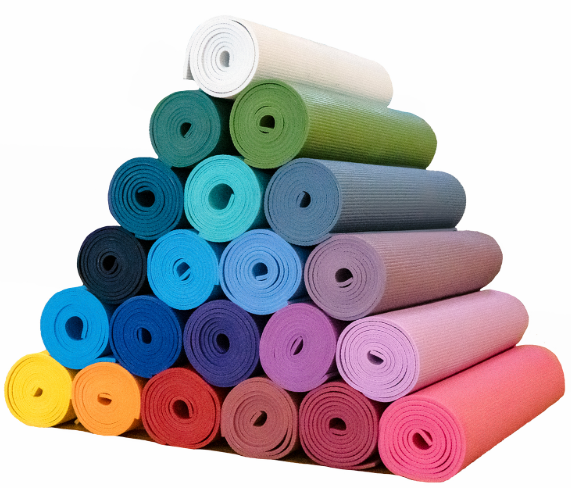
Pros:
– Low cost, usually $20 to $50.
– Strong and you can find it in many shops.
Cons:
– Not good for the planet. It’s less sustainable than other choices.
– It has man-made materials some people might not like.
TPE (Thermoplastic Elastomer)
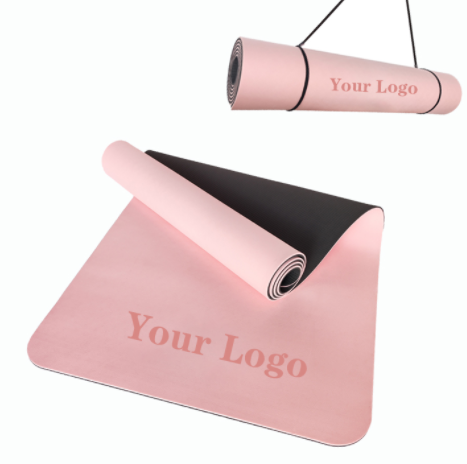
I find this one interesting.
Pros:
– Good for the environment. It’s often made from recycled stuff.
– Gives good cushioning for your joints. It costs between $30 to $60.
Cons:
– Not as tough as PVC. It might wear out quicker if you use it a lot.
Natural Rubber
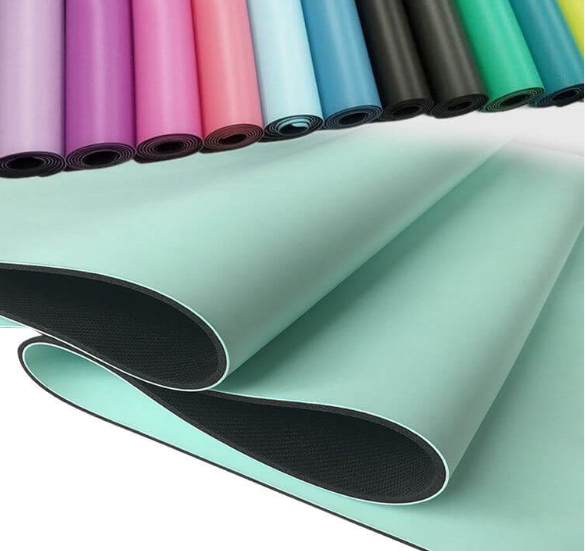
Pros:
– It gives you great grip and support. This helps you hold poses when you practice.
– It’s biodegradable. The cost is $40 to $80.
Cons:
– It can wear down after a while.
– It’s heavier than other mats. It might also have a slight rubber smell.
Jute

Pros:
– Good for the planet because it’s made from natural plant fibers.
– It has a special texture. This gives a different feel when you practice. Prices range from $35 to $75.
Cons:
– It might not be as soft or bendy as other materials.
Cork

Pros:
– It’s anti-microbial, which I believe helps keep it clean.
– The grip gets better when it’s wet. This makes it good for hot yoga.
Cons:
– It usually needs a rubber bottom to be stable.
– It costs more. This can make it harder to find lower-cost custom mats.
PU (Polyurethane)

Pros:
– It has a very strong grip. The quality is professional level.
– I recommend it for laser engraving, which is great for branding.
Cons:
– It costs more. There aren’t many planet-friendly choices for this material.
Suede / Microfiber
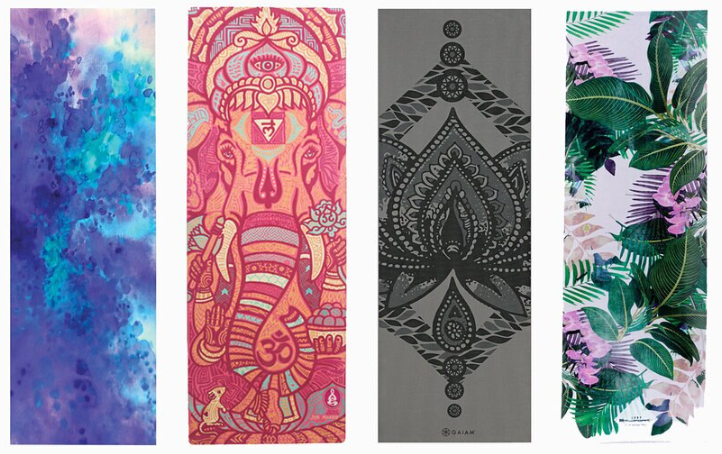
Pros:
– The surface is soft. I find it great for hot yoga.
– It’s good for sublimation printing if you want custom designs.
Cons:
– It needs to be a bit damp to give you good grip.
I hope this look at each material helps you. Now you can pick what’s best for you. Think about comfort, how long it will last, if it’s good for the planet, and your budget.
Matching Material with Your Custom Branding Needs
I believe choosing the right material for your custom yoga mat is very important. It helps match your brand’s style. The materials you pick affect how your customers connect with your mats. They also show what your brand stands for.
Digital Printing vs. Laser Engraving: What Works Best?

For customization, your branding method is key. I find that for bright, colorful designs, digital printing is excellent on materials such as PVC and TPE. This makes the colors really stand out. On the other hand, I recommend laser engraving for natural rubber and cork. This gives a classy look and lasts a long time. I suggest you think about your brand aims when you pick the material.
Choosing Material Based on Your Target Customers
I think it’s smart to consider who will use the mats.
– Hot Yoga Lovers: For these yogis, I recommend materials that offer great grip when wet. Cork and microfiber are perfect. From my experience, these customers want mats that perform well and feel good.
-
Eco-Conscious Yogis: I suggest you choose earth-friendly options like jute and natural rubber. These materials show you care about the planet. This really connects with this group.
-
Budget Gyms: PVC mats are a good choice because they are low-cost and strong. They are usually priced between $20 to $50. I find they work well for places with many users where price is important.
My OEM/ODM Tips for Material Selection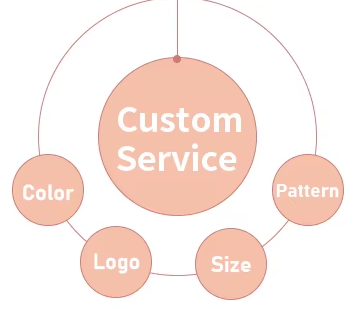
If you are selecting materials for OEM or ODM projects, I have a few tips:
– Know Your Audience: I believe it’s key to find out what your customers like.
– Material Customization: Make sure you can customize the material. It should work well with printing or engraving.
– Quality vs. Cost: I suggest you balance material costs with how long they should last and how comfy they should be. Based on my experience, PVC and TPE are good value. Natural rubber feels more high-end but costs more.
In my opinion, if you match your materials to your branding needs, you create a great product. This product will work well. It will also make your brand stronger in the market.
Our Recommendation Manufacturer
When you choose a manufacturer for your custom Yoga mats, I recommend you consider a few key factors. These factors should match your brand’s goals and what your customers need. I suggest manufacturers who are excellent with high-quality materials and also offer great customization options.
Material Quality and Variety
I suggest looking for manufacturers that offer many material types. This includes options good for the environment, like TPE and natural rubber. From my experience, these materials ensure durability. They also appeal to consumers who care about the environment. Make sure they offer choices in the price range of $20 to $80 to fit different budgets.
Customization Capabilities
I believe customization is very important for branding. I suggest partners who provide both digital printing for colorful designs and laser engraving for a higher-end look. I find this flexibility helps you make your mats different. It also helps match them with your brand’s identity.
Responsive Communication and Support
I recommend you choose manufacturers who make communication and support a priority. A partner who responds quickly can be very helpful. They can guide you as you pick materials. They will also make sure your specific needs are met and that you stick to your timelines.
How FDM Yoga Helps Clients Choose the Best Materials

I’ve observed that FDM Yoga is quite good at helping clients select the best materials for their custom mats. They look at what a business needs and what individual customers prefer to give specific suggestions.
Examples of Successful Custom Projects
I’ve seen FDM Yoga complete several impressive custom projects. For instance, they worked with fitness studios to create mats from natural rubber and cork. These appealed to yogis who prefer earth-friendly products. I think their careful work and custom choices helped these brands become more visible and gain loyal customers.
Balancing Budget, Performance, and Design
It is very important to balance your budget with the mat’s performance. FDM Yoga helps clients find the right material for them. This could mean choosing an affordable TPE or a top-quality natural rubber. From what I’ve seen, they focus on delivering good performance without asking clients to overspend. This approach helps make yoga open to everyone.
Summary
Choosing the right material is one of the most important steps in creating a custom yoga mat that truly reflects your brand and supports your customers’ practice. Whether you’re prioritizing eco-friendliness, superior grip, or standout aesthetics, there’s a material that matches your goals. From TPE and natural rubber to cork, PU, and suede, each option brings its own advantages to the table.
If you’re unsure which material fits best with your brand vision or client needs, FDM Yoga is here to help. As a leading custom yoga mat manufacturer, we offer expert guidance, low minimum order quantities, full OEM/ODM support, and a wide range of materials to choose from. Let us turn your ideas into a premium yoga product that sets you apart in the market.
Contact FDM Yoga today to explore your custom mat options and get material samples that match your vision.

